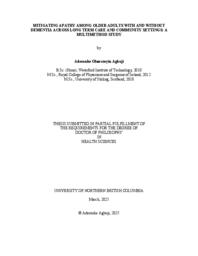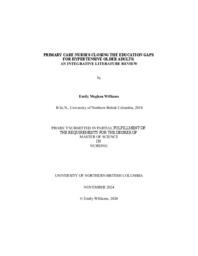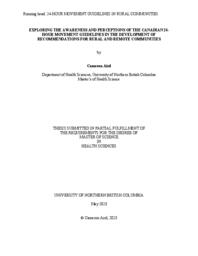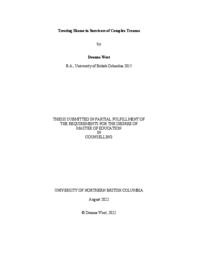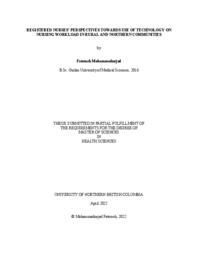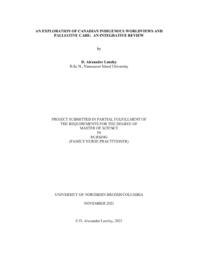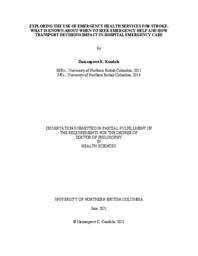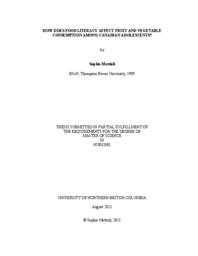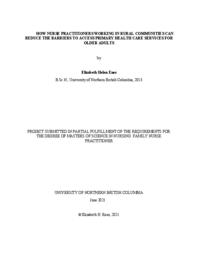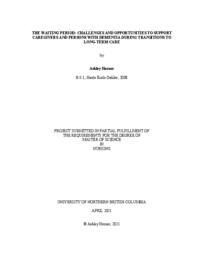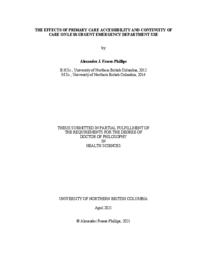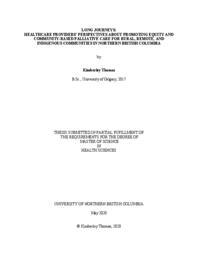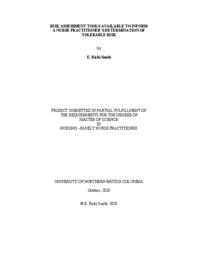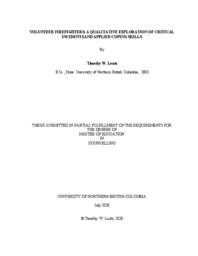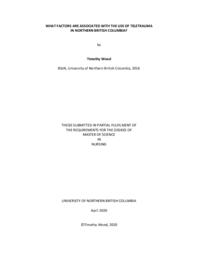Banner-Lukaris, Davina
Person Preferred Name
Davina Banner-Lukaris
Related Works
Content type
Digital Document
Origin Information
Content type
Digital Document
Origin Information
Content type
Digital Document
Origin Information
Content type
Digital Document
Description / Synopsis
The high prevalence of hypertension among the Canadian older adult population is a significant public health care issue. The evidence indicates that primary care nurses are crucial in providing high-quality care and education for older adults diagnosed with hypertension. Further, nurses can close education gaps by focusing on lifestyle modification and action strategies. This project aimed to conduct an integrative literature review investigating the proposed research question: “How can nurses close the educational gaps for older adults diagnosed with hypertension by addressing the risk factors in the primary care setting?” A comprehensive search of several databases retrieved 19 primary sources that provided evidence related to hypertension education for older adults. The following themes emerged from the research: hypertension education, knowledge translation tools, barriers, cultural sensitivity and inclusivity, therapeutic interpersonal relationships, and a collaborative approach. A gap analysis was conducted in Prince George, British Columbia. The gap analysis further solidified the evidence found in the primary research. Recommendations for enhancing education, practice, and future research are discussed concerning hypertension education based on nurse encounters with older adult patients in the primary care setting. The findings from this project have important implications for supporting the nurse’s educational role in the treatment and management of hypertension among the older adult population.
Origin Information
Content type
Digital Document
Origin Information
Content type
Digital Document
Description / Synopsis
The Canadian population is aging, and rates of obesity are also on the rise. These demographic changes have implications for the long-term care (LTC) system in Canada that need to be better understood, yet little is known about the population with obesity in Canadian LTC. In this thesis, an exploratory analysis of residents newly entering LTC between 2010 and 2020 is provided. Cross-tabulations and chi-squared statistical testing (p≤0.001) were employed to analyze retroactive, consecutive cross-sectional initial assessment data (N=350,348) from the Canadian Institute for Health Information’s (CIHI) Community Care Reporting System (CCRS) to explore the levels of obesity, demographic characteristics (age, sex, primary language, rural or urban previous residency), rates of health conditions, and independence and assistance levels of activities of daily living (ADLs). Over the full study period, the rate of obesity for the population entering LTC was 19%, and 7% entered with at least class II obesity (≥35 kg/m2). Rates of obesity and BMI obesity categories tended to increase incrementally over the course of the study period. Those entering LTC with obesity were more likely to be younger, female, English/French speaking, and arriving from rural areas. Individuals with obesity had lower rates of dementia and higher levels of independence when performing ADLs. They also exhibited higher rates of diabetes and a greater need for two+ person assistance for ADLs. This thesis begins to fill in the gap in our understanding of the population with obesity in LTC, providing a broad picture of the heterogeneous nature of the population, including important differences in health and ADL profiles across the three obesity BMI categories (i.e., classes I-III).
Origin Information
Content type
Digital Document
Description / Synopsis
The present study evaluated the awareness and knowledge of the Canadian 24-Hour Movement Guidelines in rural and remote communities, and explored how to adapt guideline communication material to improve their impact and relevance. People living in rural and remote communities completed a cross-sectional survey (N = 76) and individual interviews (N = 12) to explore what is known about the guidelines and provide recommendations to help adapt the materials to local context. Overall, most participants were aware of the guidelines (44.7%) and had moderate knowledge of recommendations and dosages (64.5%). Deductive thematic analysis was used to code the barriers and facilitators to meeting guideline recommendations and map them onto the Behaviour Change Wheel. Recommendations for adapting the guidelines were created which included: providing additional information on being active outdoors and at home, information discerning sedentary behaviour and inactivity, and tips to combat seasonal changes in daylight.
Origin Information
Content type
Digital Document
Description / Synopsis
Understanding how counsellors authentically integrate their personal and professional selves into a congruent identity is still in progress. The current study employed an exploratory research methodology to answer the question, what are the experiences of counsellors in understanding and developing their authentic selves in the therapeutic relationship? Six master’s level participants were recruited and engaged in semi-structured interviews. Using reflexive thematic analysis to analyze the data, four themes were generated, each containing subthemes. The four themes included: dissolving fear, which described the outset of the participants’ journeys as counsellors and the returning point for new challenges; surrendering to self, which involved the recognition and trust of innate abilities and knowing; cultivating capacity, which highlighted the advancement of personal awareness and the ability to hold therapeutic space; and aligning with authenticity, which detailed the subjective accounts of the counsellors as their congruent selves. Findings from the present study contribute to the growing body of research that explores how a congruent use of Self benefits the counsellor, client, and therapeutic relationship. Recommendations for counsellors include incorporating personal and professional practices that help refine their inner attunement ability and to continue expanding their awareness of their authentic selves to determine how they want to engage in the therapeutic relationship.
Origin Information
Content type
Digital Document
Description / Synopsis
While research continues to establish a connection between shame and complex trauma, there is a lack of understanding on how this is addressed in therapeutic practice. The current research employed a qualitative exploratory research methodology to answer the question, how do counsellors perceive and treat shame in adult survivors of complex trauma? Seven counsellors were recruited to engage in a virtual semi-structured. The data was analyzed using thematic analysis resulting in three main themes, each containing various sub-themes. The three themes are emotional landscape, which pertains to the emotional effects of shame and how they can be treated in therapy; self-concept, which explores the negative beliefs and thinking patterns clients develop and suggests techniques for diffusing shame; and attachment and the therapeutic relationship, which highlights interpersonal difficulties faced by clients and the impact of the therapeutic alliance, along with exploring the personal experience of counsellors in the therapeutic relationship.
Origin Information
Content type
Digital Document
Description / Synopsis
Background: Technology has an important role in health delivery. One of the uses of technology in the healthcare field is to reduce Registered Nurses’ (RNs) workload. Reducing RNs’ workload can increase health delivery efficiency. Objective: To find out RNs’ perspectives towards the use of technology, including the Steadiwear glove, on their workload in rural and northern communities. Methods: A literature review was conducted, guided by a scoping review methodology and 35 articles were included. Subsequently, semi-structured interviews were conducted with eleven RNs who shared their perspectives towards technology use on their workload. Thematic analysis and an inductive approach guided by Creswell and Creswell, (2018) was undertaken. Results: Two main themes and six subthemes about the effects of technology use on RNs’ workload were found. The results revealed some technologies like the Steadiwear glove have the potential to decrease RNs’ workload by increasing the independence of persons' living with Essential Tremor (ET) and Parkinson’s Disease (PD). Further, the results demonstrated participants’ perspectives towards five technology categories including, Information and Communication technologies, E-communication, E-learning, mHealth, and Assistive devices. Elearning was the technology most commonly described by the participants and mHealth use was described the least. Factors such as decision-making based on urban setting, technology resources, and suitable training and support for using technology may affect RNs’ workload. Conclusion: Different types of technology may affect RNs’ workload depending on factors such as nurses’ acceptance, patients’ acceptance, educating users, healthcare setting (urban or rural), and technology support.
Origin Information
Content type
Digital Document
Description / Synopsis
Background: Some Indigenous people suffer from a disproportionate prevalence of life limiting conditions, with increased mortality and decreased life-expectancy compared to non-Indigenous populations. Reduced uptake of palliative care services by Indigenous populations is concerning and further cultural understanding is needed to improve delivery of palliative care services. This review explores Indigenous user experiences with palliative care in Canada through the research question: How does a worldview affect the delivery of palliative care services to Indigenous people living with life limiting conditions? Method: Seven primary source articles are analyzed concerned Inuit and First Nation and Métis perspectives on palliative care. Summative themes identified including traditional and contemporary experiences, EOL beliefs, EOL preferences, EOL communication, EOL capacity, EOL resource and policy limitations, and recommendations for palliative care improvements. Dialogue examples accompanying the themes are analysed with Hiebert's Worldview Model concerning nine worldview features including time, self-concept, space, feeling, preference, sensation, food, beliefs, emotion and ethics, values, and judgement. Results: some Canadian Indigenous people's self-concept and spiritual beliefs may conflict with western individualistic delivery of care, and serious illness conversations. Conclusion: Culturally sensitive and competent approaches to palliative care marginally improve care delivery for Indigenous populations, but the do not improve health equity. A cultural safe approach to palliative care can help address health equity for Indigenous people and lead to increased culturally accessible, accommodating, and acceptable EOL care.
Origin Information
Content type
Digital Document
Description / Synopsis
Self-insight has been identified as an important predictor of psychological well-being, and it is commonly believed that self-insight is achieved through self-reflection. However, findings regarding the relationship between self-reflection and self-insight remain largely inconsistent warranting further examination of the determinants of the outcomes of self-reflection. This thesis examined the relationship between self-reflection, self-insight, and psychological wellbeing as a function of individual differences in identity styles, while also considering the roles of rumination and self-compassion. Two hundred and twenty-six emerging adult women (N = 165) and men (N = 61) completed self-report measures of identity styles, self-reflection, self-insight, psychological well-being, rumination, and self-compassion via the University of Northern British Columbia (UNBC) Psychology Research Participation System in the time from September 2020 until April 2021. Self-insight and self-compassion partially mediated the positive relationship between informational identity processing and psychological well-being. For users of the diffuse-avoidant and normative identity styles, rumination negatively predicted psychological well-being. This relationship was fully mediated by self-insight and self-compassion. The results are discussed in terms of the roles of self-reflection, self-insight, and self-compassion in fostering psychological well-being. Findings highlight the importance of self-compassion as a precedent in order to adaptively self-reflect, gain self-insight and increase psychological well-being. Any attempts at increasing self-insight that are not done in a self-compassionate way pose a risk to an individual’s psychological well-being; this risk is especially high when diffuse-avoidant or normative identity processing is used. The primary implication is that a consideration of self-compassion is warranted in therapy and other practices relying on self-reflection.
Origin Information
Content type
Digital Document
Description / Synopsis
Transport practices for seeking emergency stroke care remain largely underresearched and poorly understood, particularly for individuals living in small urban, rural, and remote regions. This multi-method study aims to address this knowledge gap and explores the impact of mode of transport on in-hospital stroke care and the decision-making process of seeking emergency medical attention for patients and their caregivers. Data from the Discharge Abstract Database provide information on stroke-related use of emergency health services across British Columbia. Data from the Canadian Institutes for Health Information Special Project 340 provide information on if calling emergency health services impacts the delivery of care, including the completion of neuroimaging, the administration of acute thrombolysis, and the prescription of antithrombotics upon discharge across a northern health region. Focused, semi-structured interviews provide contextual insight into the decision-making processes for seeking emergency stroke care among patient and caregiver participants in a northern health region. Stroke-related emergency health service use across British Columbia from January 2015 to March 2018 was 67.9% (N=19,849), ranging from 58.8% in Northern Health to 70.2% in Fraser Health. In Northern Health (N=784), there were differences between health service delivery areas for stroke-related emergency health service use ranging from 53.7% in the Northwest to 64.8% in the Northern Interior from January 2015 to March 2018. Similar differences in thrombolytic therapy administration and the prescription of antithrombotics were noted. The odds of emergency health service use were greater for those 65 years of age and older than those younger than 65 and lower for those in the Northwest health service delivery area than those in the Northern Interior health service delivery area. Differences were found for the completion of neuroimaging between males and females. Interviews for patient (n=12) and caregiver (n=7) participants provide complementary contextual insights and yielded three key themes, including the decision-making process following a stroke, experiences of care, and perceived gaps and areas in need of further support. This integrated knowledge translation-informed and practice-driven research addresses health services and policy priorities. Findings are anticipated to help inform the development and refinement of emergency health services in British Columbia by highlighting differences in emergency health services use across geographies and identifying factors that inform patient decisionmaking when seeking emergency medical attention.
Origin Information
Content type
Digital Document
Description / Synopsis
Background. Adolescents are losing the opportunity to observe and practice food skills since diets are shifting from home prepared meals made from basic ingredients to a diet comprised of ultra-processed foods, resulting in reduced consumption of minimally processed foods such as fruits and vegetables. Evidence suggests that engaging in food preparation during adolescence is associated with ongoing healthy dietary behaviours and food preparation practices into adulthood, thus developing food preparation skills in adolescence may help better support individuals to make health informed food choices. Food literacy represents the interdependent concepts related to the facets influencing dietary practices. The objective of the current study was to examine the association between food literacy and fruit and vegetable consumption (FVC) among Canadian adolescents. Methods. Guided by the food literacy framework developed by Thomas et al. (2019), a secondary analysis was conducted on the Canadian Community Health Survey, Rapid Response on Food Skills (Part 2) – mechanical skills and food conceptualization. The sample population (N=790) included all survey respondents aged 12- 17 years who responded to the survey questions that built the outcome variable: total daily fruit and vegetable consumption. Results. When compared to respondents who report low levels of food skill, respondents who reported high food skill levels in the ability to cook from basic ingredients (OR 1.84, 95% CI 1.12-3.02), freeze vegetables from raw (OR 1.50, 95% CI 1.00-2.24), and to adjust a recipe to make it healthier (OR 3.02, 95% CI 1.29-3.26) were more likely to consume fruits and vegetables five or more times a day. Respondents who came from households where the highest level of household educational attainment was trades had lower odds of consuming fruits and vegetables five or more times a day compared to households where the highest level of educational attainment was a bachelor’s degree or higher (OR 0.34, 95% CI 0.14-0.81). Within the logistic regression model, significant relationships were found between FVC and a respondent’s sex (p=0.04), perceived eating habits (p<0.001), and highest level of household educational attainment (p=0.02). Discussion. Significant relationships between FVC and food literacy were evident in food skills that were multifaceted, requiring that adolescents have the ability to perform a number of basic food skills and reflective of several food literacy attributes. The relationships found between multifaceted food skills and adolescent FVC suggest that food literacy attributes are interconnected and have reciprocal relationships. Conclusion. Dietary behaviours are influenced by multiple factors. Study findings suggest that higher levels of adolescent food literacy, as reflected in multifaceted food skills, have the potential to positively impact their FVC. However, when societal factors are controlled for, food skills were not found to have a significant relationship with adolescent FVC, suggesting that factors outside of the control of the individual have the potential to minimize the influence of individual food literacy characteristics on adolescent FVC. Future food literacy programs should be inclusive of adolescents from all SES and should aim to teach and evaluate food literacy attributes that build more complex food skills.
Origin Information
Content type
Digital Document
Description / Synopsis
Due to the aging population worldwide, need to access primary health care (PHC) services is increasing. Older adults are at a heightened risk of developing chronic diseases, poor health outcomes, and increased emergency department visits. Living in rural communities also increases the risk of chronicity for older adults due to a lack of PHC resources. However, there is limited information available to provide insight into how healthcare providers can reduce barriers to access to PHC for older adults. As PHC providers, nurse practitioners are in a position to implement strategies to reduce barriers older adults in rural communities face with accessing PHC services. An integrative literature review was conducted to identify barriers nurse practitioners within rural communities can reduce to improve older adults’ access to PHC services. An analysis of the literature revealed the complexity of barriers that prevent older adults from accessing PHC services in rural communities. Environmental, systemic, and individual barriers were reviewed alongside programs and interventions relevant to reducing barriers in the findings. Findings from the literature review suggested strategies to reduce these barriers, which nurse practitioners can promote in the PHC setting. These strategies include virtual care, home visits, nurse practitioner-models of care, interdisciplinary teamwork, and role clarification. In addition to these strategies, implications for practice, limitations of the study and suggestions for future research are discussed.
Origin Information
Content type
Digital Document
Description / Synopsis
Heart failure is a chronic, progressive disease that remains on the rise partially due to improvements in preventing cardiac related mortality from other causes. Implanted cardioverter defibrillators are indicated for patients that are at high risk for sudden cardiac death from ventricular arrhythmias (primary prevention), or for those who have survived a cardiac death (secondary prevention). Guidelines suggest simple and easy to follow directions for providers to determine which patients would be eligible to be considered for a device. However, despite national guidelines, research supporting cost effectiveness, and a repeatedly demonstrated reduction in mortality with device therapy, referral and utilization of ICDs remain low, with most of the non-referral and underutilization rates identified within the primary care provider group. In addition, for those patients who do receive ICDs, advanced care planning with consideration of deactivation of the device at end-of-life is rarely completed, leaving many patients at risk of undignified and painful shocks delivered within the last hours to days of life. This integrative review seeks to explore: Primary care management of the heart failure patient requiring an implanted cardioverter defibrillator. A comprehensive search of the literature was undertaken and 15 articles were selected for inclusion This review establishes that ICDs are effective and relatively low-risk devices that have significant mortality benefits, and patients with HF should be screened routinely for eligibility for the device in order to help prevent SCD. Furthermore, patients who receive an ICD should complete an informed advance care directive which includes directions for management of the ICD at end-of-life. ICD management, while often deferred to specialists, requires a collaborative approach and consistent evaluation from the patient’s primary care provider, as it has the potential to influence all aspects of patient’s quality of life, as well as quality of end-of-life care. Recommendations for practice, education, further research, and policy have been made to support the role of primary care providers, such as Nurse Practitioners, in the management of HF patients requiring an ICD.
Origin Information
Content type
Digital Document
Description / Synopsis
Transitions to long-term care are significant and often challenging experiences for older adults with dementia and their caregivers, with waiting lists a common occurrence due to an aging population and a limited supply of long-term care beds. To better understand the complexities related to transitions to long-term care and inform clinical practice, a comprehensive project was undertaken and included an integrative literature review and a gap analysis of local practices in the interior of British Columbia. The literature review and gap analysis findings were analyzed and presented thematically through interrelated themes, including key concepts surrounding the phases of a transition, caregiver coping, and professional support. Four key recommendations arose from this project regarding continuity and coordination of care, discharge planning, post-discharge care, and evaluation. The strengths, limitations, and implications of this project are discussed, including next steps to mobilize knowledge related to the recommendations and influence evidence-informed changes in practice.
Origin Information
Content type
Digital Document
Description / Synopsis
Background/Aims. Since the early 2000s, Canada’s primary care system has undergone substantial reforms, including the incorporation of interdisciplinary teams and strategies to optimise accessibility. However, the effects of primary care accessibility and continuity of care on less-urgent emergency department (ED) use are unclear. Three studies were undertaken to investigate the effects of primary care accessibility and continuity of care factors on less-urgent ED use. Methods. Study One employed a cross-sectional analysis of responses to the Canadian Survey of Experiences with Primary Health Care to predict self-reported ED visit avoidability; Study Two employed a longitudinal time-to-event analysis of responses to Ontario’s Health Care Experience Survey linked with subsequent National Ambulatory Care Reporting System data to predict medically assessed less-urgent ED use; and Study Three employed time-series analyses of presentations to two northern British Columbia EDs following changes in walk-in clinic coverage. Results. Study One (n = 2,625) found no significant associations between self-reported ED visit avoidability and all measures of primary care accessibility and continuity of care. However, rural respondents reported greater ED visit avoidability. Conversely, Study Two (n = 34,686) found that all accessibility factors were significantly associated with medically assessed less-urgent ED use, including the presence of a regular PCP, the regular source of care, and the availability of after-hours care through the PCP. However, time with the same PCP was not associated with medically assessed less-urgent ED use. Rurality was also found to moderate the effect of after-hours care accessibility, with only rural respondents reporting a beneficial effect. Finally, Study Three found that changes in walk-in clinic coverage resulted in short-term impacts on less-urgent ED use, with a walk-in clinic closure resulting in an immediate increase in less-urgent presentations and an opening resulting in an immediate decrease. Conclusions. The findings of Studies Two and Three provide evidence that primary care accessibility factors are associated with medically assessed less-urgent ED use; however, the findings of Study One suggest that these factors do not influence self-perceived ED visit avoidability. Future studies should consider this discordance when measuring the impact of primary care accessibility on less-urgent ED use.
Origin Information
Content type
Digital Document
Description / Synopsis
Pediatric patients in northern BC have some of the highest asthma prevalence rates compared to children in other areas of the province. Adequate parental health literacy skills are particularly important to make informed health management choices when caring for children with asthma. In this project, a gap analysis process was followed, and three evidence-informed practice gaps related to pediatric asthma care were identified. Findings highlight the need for increased asthma education and parental health literacy resources to address concerns mentioned during stakeholder engagement. Four key recommendations were formulated regarding parental health literacy assessments, clear language requirements for written asthma materials, access to specialized care resources, and adaptation of current asthma education models. In conclusion, the development of a working group that includes asthma and health literacy stakeholders, is the next step to address the findings of this project and improve the overall asthma health outcomes for children in northern BC.
Origin Information
Content type
Digital Document
Description / Synopsis
Inequitable access to palliative care in Canada is a pressing issue. People with life-limiting illnesses in rural and remote northern and Indigenous geographies in British Columbia (BC) face ethically problematic barriers to receiving palliative care. Palliative approaches that are equity-oriented and community-based bring significant improvements to the healthcare system and to people's quality of life. The purpose of this qualitative study was to find ways to promote health equity and community-based palliative care. This research is informed by action-oriented, anti-colonial, and critical Indigenous methodologies. As perspectives of frontline healthcare workers offer transformative insights, palliative care providers working in northern BC were interviewed, and, from their interviews, three main themes emerged. These were (1) Support Primary Palliative Care, (2) earlier and inclusive Integration of Palliative care, and (3) Culturally Safe Palliative Care. The implications of these findings are situated at the intersection of cultural safety, public health, and health promotion.
Origin Information
Content type
Digital Document
Description / Synopsis
Risk in health care, often discussed in terms of its tolerability, is an abstract term that is patient- and context-specific. An older adult living at risk can be someone falling frequently at home risking a fractured hip, to someone self-neglecting. Family Nurse Practitioners working in Primary Care are well-situated to support patients over time and to mitigate risk. A better understanding of the risk assessment tools available to inform a level of risk tolerability for Nurse Practitioners working in Primary Care may enhance clinical reasoning and enhance their comfort with the concept of risk, resulting in consistent care delivery for patients. Evidencebased literature highlights the complexity of both defining and assessing risk, which is further reflected within the assessment tools. For these reasons, the purpose of this integrative literature review is to provide recommendations, founded in current literature findings, regarding the comprehensive risk assessment tools used to inform a Nurse Practitioner’s determination of tolerable risk for community-dwelling older adults. A search of three databases, as well as hand searches, resulted in nine tools for analysis. The interpretation of the findings suggested that risk assessment tools varied in their approach to risk, with some focused preventatively on risk mitigation while others could be applied in real-time to assess the severity of a perceived risk. Each tool included elements of risk which together, comprise a comprehensive, holistic risk assessment to be considered in the ongoing assessment of tolerable risk. A positive risk-based approach is also a shift in risk perception that Nurse Practitioners are encouraged to consider. The implications for practice include how the described approaches guide decision-making and the definitions of tolerable and intolerable risk can steer the Nurse Practitioner’s care, as well as to inform future research and the development of new risk assessment tools.
Origin Information
Content type
Digital Document
Description / Synopsis
Difficulties in mentalization may be a developmentally based foundation for interpersonal problems in Borderline Personality Disorder (BPD). Fonagy and colleagues have developed a theoretical framework whereby relationships between difficulties in mentalization and other core characteristics of BPD (i.e., insecure attachment, intrapersonal emotion dysregulation and identity diffusion) may underlie interpersonal problems. However, most of the published work on these aspects of the framework have been theoretical in nature. The aim of the study was to investigate this framework and extend it by including interpersonal emotion dysregulation. Simple and multiple mediation analyses were performed with a convenience sample of 64 undergraduate students. Results indicated that hypomentalizing mediated the relationship between BPD symptoms and interpersonal problems. No significant mediators were found between insecure attachment and interpersonal problems or between mentalization errors and interpersonal problems. Limitations include the sample size and the lack of a negative emotion induction and recommendations for future research are suggested.
Origin Information
Content type
Digital Document
Description / Synopsis
Background: The prevalence of Alzheimer’s disease (AD) and other dementias is perpetually increasing in Canada and worldwide with the aging baby boomer population. It is, therefore, important to identify risk factors for these major neurocognitive disorders, such as alcohol consumption, to mitigate the future burden on caregivers and the economy. The purpose of this study was to replicate previous research regarding the dose-response relationship between alcohol consumption and the odds of currently having AD or another dementia. The possibility of a sex effect moderating this relationship was also explored. Participants: Data were obtained for respondents to the combined 2015/16 cycles of the Canadian Community Health Survey who were aged 41 years or older at the time of the survey’s conduction (nweighted = 16,715,618). Methods: Logistic regression was used to crossectionally assess the relationship between various time- and frequency-related alcohol consumption exposures to outcome dementia status, while controlling for a number of demographic and risk factor variables. Results: A sex effect was identified for drinking at an average frequency of four to six times per week over the past year (p = 0.019, 95% CI: 0.03, 0.73) where women (ORw = 0.13) were more protected against currently having AD or dementia than men (ORm = 0.89) when compared to alcohol abstainers. Binge drinking two to three times per month (OR = 0.19, p = 0.015, 95% CI: 0.05, 0.73) and more than once per week over the past year (OR = 0.16, p = 0.007, 95% CI: 0.04, 0.61) significantly lessened the odds of currently having AD or dementia when compared against alcohol abstainers. A sex effect was present for those who were classified as very heavy drinkers (♂: 6+ drinks/day, ♀: 4+ drinks/day) over the past week (p = 0.018, 95% CI: 1.14, 39.41) where alcohol was protective against currently having AD or dementia in men (ORm = 0.29) and alcohol was a risk factor for currently having AD or dementia in women (ORw = 2.15) when both were referenced with alcohol abstainers. Conclusions: With the exception of very heavy drinker women, drinking alcohol was associated with a reduced likelihood of currently having AD or dementia and sex effects were identified for drinking at a moderate frequency over the past year and very heavy drinkers. However, these results should be interpreted with caution due to the possibility of selection, sparse data, and abstainer biases as well as misclassification error. The primary implication of this research is to inform future studies that a more thorough exploration of a sex effect influencing the relationship between alcohol consumption and having AD or dementia is warranted.
Origin Information
Content type
Digital Document
Description / Synopsis
Volunteer firefighters have limited up-to-date training and awareness in applied coping skills and trauma informed practice (TIP). Critical Incident Stress Management (CISM) has been a standard of practice within emergency services — including fire rescue services — for decades in Northern British Columbia. With new developments in TIP, I suggest we can further improve volunteer firefighters’ wellness by exploring specific coping strategies. The purpose of this endeavour was to interview volunteer firefighters, explore their experiences, and better understand their coping styles and approaches to managing stress related to the work. In the exploration of critical incident coping skills, a qualitative methodology and thematic analysis was applied. This study adds to the current literature on work-related coping, and hopefully increases awareness of best practices for psychological safety and wellness of volunteer firefighters in Northern British Columbia.
Origin Information
Content type
Digital Document
Description / Synopsis
Despite the existence of universal health care for Canadians, health inequalities persist. Those residing in rural regions of Canada may be at a disadvantage for accessing appropriate services. To enhance access, a teletrauma program was implemented in the Robson Valley, connecting rural clinicians during emergency cases. This study was undertaken to better understand the experiences of teletrauma users and why teletrauma is utilized. Data were gathered from 14 interviews with clinicians, health administrators, a researcher, and a health executive. Guided by interpretive description methodology, four major themes emerged, including: teletrauma affects the entire system of care; teletrauma enables a network of care built on interprofessional relationships; reasons clinicians use teletrauma are multifaceted and interrelated; and, interconnectedness of the healthcare system. Information from this study provides insight into the role and function of teletrauma in northern British Columbia and how it may better serve the needs of rural clinicians.
Origin Information



